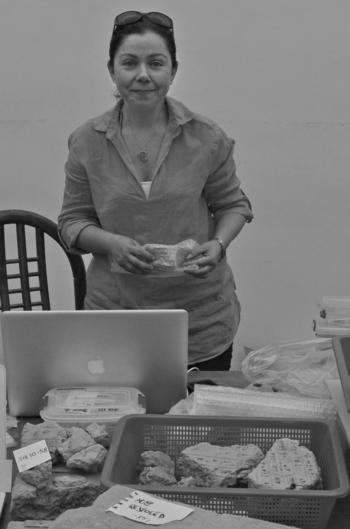Cinzia Pappi (März 2019-Mai 2020)

Freie Universität Berlin
Gastwissenschaftlerin
Dr. Cinzia Pappi ist Assyriologin und Vorderasiatische Archäologin. Ihre Forschungschwerpunkte sind die religiösen Landschaften und die sozialpolitische Geschichte Syriens und Nordmesopotamiens. Nach ihrer Promotion an der Universität Udine (Italien) mit einer Dissertation über die religiösen Landschaften der Mittelbronzezeit in Syrien arbeitete sie als akademische Assistentin an der Universität Leipzig (Deutschland), der Brown University (U.S.A) und an der Universität Innsbruck (Österreich) als Gastprofessorin. Sie hat an mehreren archäologischen und epigraphischen Projekten in Italien, Syrien, und dem Irak teilgenommen. Seit 2010 ist sie in mehreren Projekten tätig. Ihre derzeitige Feldforschung umfasst einen archäologische Survey in der Region von Koi Sanjaq/Koya (Erbil, Irak) und Ausgrabungen in Qala Šīla (Irak).
Dr. Cinzia Pappi is an assyriologist and a near eastern archaeologist whose main scientific research is focused on the religious landscapes and socio-political history of Syria and Northern Mesopotamia. She obtained her PhD in 2007 at the University of Udine (Italy) with a dissertation on the religious landscapes of the Middle Bronze Age in Syria. She was Assistant Professor at the University of Leipzig (Germany), visiting professor at Brown University (USA) and at the University of Innsbruck (Austria). She has been involved in several epigraphic and archaeological projects in Italy, Syria, and Iraq. Since 2010, she has worked in Iraqi-Kurdistan co-directing excavations at Satu Qala. In 2016 she began her current fieldwork with an archaeological project in the region of Koi Sanjaq/Koya (Erbil, Iraq), which pairs a regional survey with archaeological excavations at Qala Šīla (Iraq).
Das Projekt „Infrastructural Developments in Early Empires” verfolgt das Ziel einer Neubetrachtung des Begriff der „Infrastruktur“ in der historischen Narrative des Alten Orients, um ihre Entstehung und ökonomische und politische Rolle in der Entwicklung innerhalb der assyrischen Provinzen und in Beziehung zu den Nachbarstaaten zu präzisieren. Archäologische Befunde und Keilschriftsquellen liefern Evidenzen für den langfristigen Ausbau eines Netzwerks von materiellen (z. B. Kommunikationsnetzwerke, Lagereinrichtungen, Bewässerungssysteme, Produktionszentren und Verteidigungssysteme), sowie immateriellen Einrichtungen (wie z. B. Staatsverwaltung, Recht und Technologien). Solche Infrastrukturen stellen eine konkrete Form der politischen Hegemonie Assyriens dar, die in allen Provinzen zum Ausdruck kommen, sich aber unterschiedlich nach der Natur der Grenzgebiete entwickeln und diverse Formen von kulturellen Landschaften innerhalb der breiten Peripherie Assyriens generieren. Als Modell soll untersucht werden, wie solche Einrichtungen zur Begünstigung der Kommunikationswege und zur wirtschaftlichen Ausnutzung der Provinzen des Ost-Tigris Gebiets beitragen und eine territoriale Hegemonie ermöglichen.
The project on "Infrastructural Developments in Early Empires" aims to a re-consideration of the term “infrastructure” in the narrative of the ancient near eastern studies, establishing a clear typological description, and questioning their political impact on limited peripheral areas of the periphery of the Assyrian Empire (e.g. the Transtigrine and the Upper Tigris regions). The creation of a network of material and non-material facilities, including political institutions, communication networks, storage facilities, irrigation systems, centers of production, and defensive systems, demarked the presence of central power and facilitated routes of communication. The development of such infrastructures within the imperial core lands and peripheries denotes the grade of hegemonic control.
The research, combining both archaeological and epigraphic primary sources, will first provide a tool to be used in historical and archaeological narratives, and, further insights into our understanding of the built landscape of Middle and Neo-Assyrian Periphery of the Transtigrine region.
Ausgewählte Publikationen/Selected Publications:
Monografien/Monographies
Discovering Idu, Excavations at Satu Qala 2010-2013 (in preparation)
Gli itinerari di culto nell’età di Mari, PhD Dissertation, University of Udine 2007.
Cuneiform Texts of the Iraq Museum. A Preliminary Catalogue. Neo-Assyrian Texts from Nimrud, Part I (Materiali per il Vocabolario Sumerico 14), Roma 2004.
Herausgeberschaft/Edited books
With G. B. Lanfranchi, D. Morandi Bonacossi und S. Ponchia, Leggo! Sudies presented to Prof. Frederick Mario Fales on the Occasion of his 65th Birthday (Leipziger Altorientalistische Studien 2), Harrassowitz 2012.
Artikel/Articles
- Between Assyria and Adiabene: Cultural Transitions in the Valley of the Lower Zab, in C. Coppin, R. Palermo, R. Pappalardo, R. Pierobon (Eds.), “Dark Ages”? Identifying Markers of Transition in Mesopotamia and the Near East on a Diachronic Scale, Workshop ICAANE 2018, Studia Chaburiensia, Harrassowitz (submitted to peer-review).
- The Land of Idu: City, Province, or Kingdom ?" State Archives of Assyria Bulletin 24 (2018) 97-123.
- Satu Qala: Stratigraphy and Material Culture of the Assyrian and Post-Assyrian Phases in K. Kopanias and John MacGinnis (eds.), The Archaeology of the Kurdistan Region of Iraq and Adjacent Regions, Oxford: Archaeopress. (2016) 297-307.
- with W. H. Van Soldt – K. Ahmad – C. W. Hess – A. Wossink, Tell Satu Qala: A Preliminary Report of the Seasons 2010-2011, Anatolica 39 (2013), 197- 239.
- Assyrians at the Lower Zab, G.B. Lanfranchi – D. Morandi Bonacossi – C. Pappi – S. Ponchia (Ed.), Leggo! Sudies presented to Prof. Frederick Mario Fales on the Occasion of his 65th Birthday (Leipziger Aoltorientalistische Studien 2) Wiesbaden: Harrassowitz 2012, 577-591.
- Religion and Politics at the Divine Table: the Cultic Travels of Zimrī-Līm, in G. Wilhelm (Ed.) Proceedings of the 54th Réncontre Assyriologique Internationale, Winona Lake: Eisenbrauns 2012.

